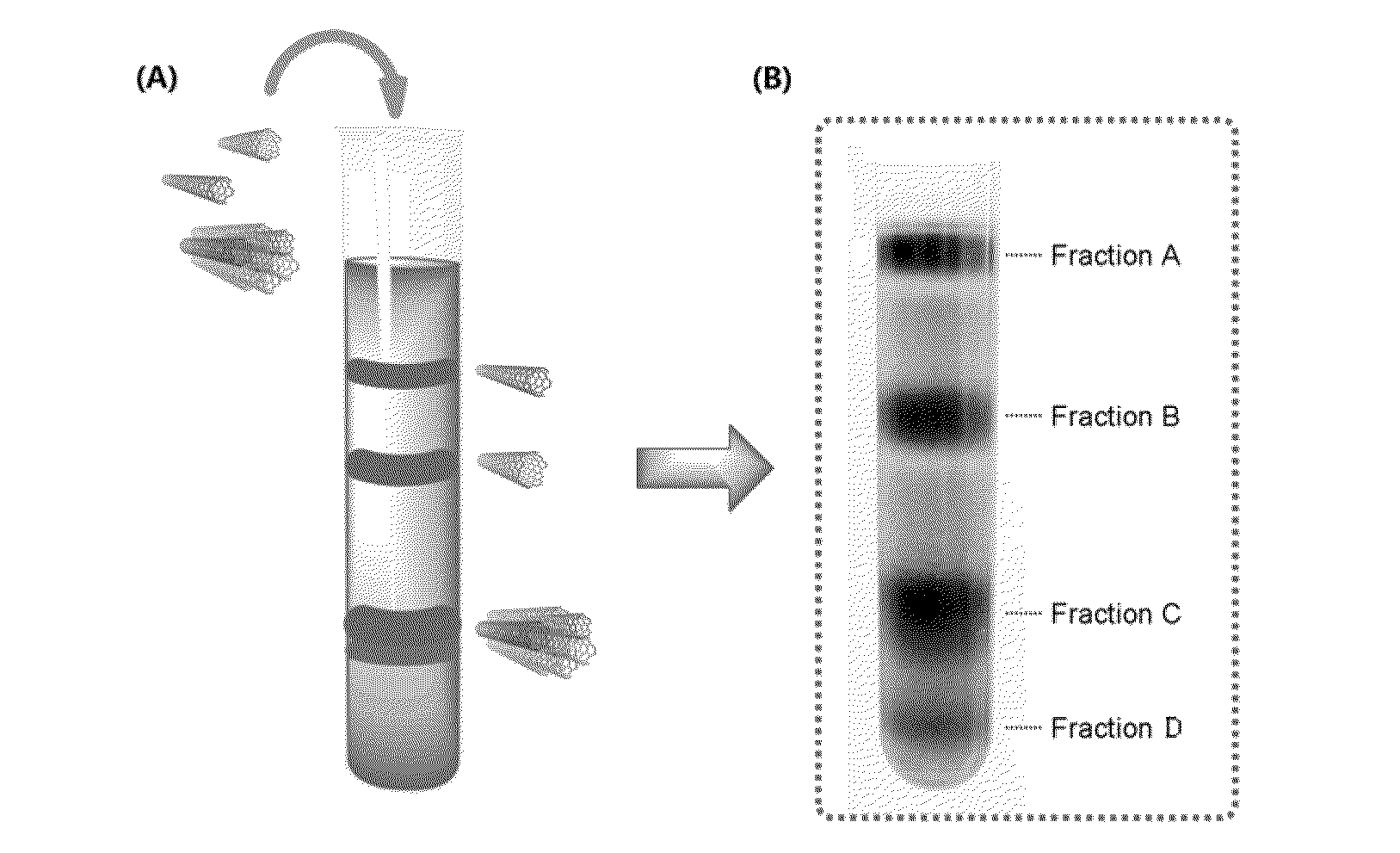Method for treating single wall carbon nanotube
- Summary
- Abstract
- Description
- Claims
- Application Information
AI Technical Summary
Benefits of technology
Problems solved by technology
Method used
Image
Examples
example 1
[0036]This example is provided to describe the method for treating single-walled carbon nanotube provided in the present invention and the single-walled carbon nanotubes obtained.
(1) Pretreatment of Single-Walled Carbon Nanotubes:
[0037]Mix 0.1 g single-walled carbon nanotubes (purchased from Chengdu Times Nano Co., Ltd., in the form of powder) with 150 mL nitric acid aqueous solution which has a concentration of 7 mol / L, allow the mixture to have reflux reaction for 12 h at 120° C., and then filter the mixture, wash the filter residue with water for 3 times, and filter and dry it, to obtained pretreated single-walled carbon nanotube powder;
(2) Dispersion of Single-Walled Carbon Nanotubes:
[0038]At 25° C., mix the product obtained in step (1) with 200 mL sodium lauryl sulfate aqueous solution which has a concentration of 5 mg / mL while stirring for 8 h, cool down the solution to 4° C., add 500 mL Rhodamine 123 aqueous solution which has a concentration of 200 μg / mL and continue to mix ...
example 2
[0041]This example is provided to describe the method for treating single-walled carbon nanotube provided in the present invention and the single-walled carbon nanotubes obtained.
(1) Pretreatment of Single-Walled Carbon Nanotubes:
[0042]Mix 0.1 g single-walled carbon nanotubes (purchased from Chengdu Times Nano Co., Ltd., in the form of powder) with 150 mL sulfuric acid aqueous solution which has a concentration of 5 mol / L, allow the mixture to have reflux reaction for 6 h at 150° C., and then filter the mixture, wash the filter residue with water for 3 times, and filter and dry it, to obtained pretreated single-walled carbon nanotube powder;
(2) Dispersion of single-walled carbon nanotubes:[0043]At 20° C., mix the product obtained in step (1) with 300 mL sodium cholate aqueous solution which has a concentration of 5 mg / mL while stirring for 12 h, cool down the solution to 4° C., add 250 mL fluorescein isothiocyanate aqueous solution which has a concentration of 400 μg / mL and continue...
example 3
[0046]This example is provided to describe the method for treating single-walled carbon nanotube provided in the present invention and the single-walled carbon nanotubes obtained.
(1) Pretreatment of Single-Walled Carbon Nanotubes:
[0047]Mix 0.1 g single-walled carbon nanotubes (purchased from Chengdu Times Nano Co., Ltd., in the form of dispersion liquid, wherein, the dispersion medium of the dispersion liquid is water, and the weight ratio of single-walled carbon nanotubes to water is 1:2, the content of single dispersed single-walled carbon nanotubes in the dispersion liquid is 7 wt %) with 150 mL nitric acid aqueous solution which has a concentration of 6 mol / L, allow the mixture to have reflux reaction for 9 h at 135° C., and then filter the mixture, wash the filter residue with water for 3 times, and filter and dry it, to obtained pretreated single-walled carbon nanotube powder;
(2) Dispersion of Single-Walled Carbon Nanotubes:
[0048]At 22° C. mix the product obtained in step (1) ...
PUM
| Property | Measurement | Unit |
|---|---|---|
| Temperature | aaaaa | aaaaa |
| Temperature | aaaaa | aaaaa |
| Temperature | aaaaa | aaaaa |
Abstract
Description
Claims
Application Information
 Login to View More
Login to View More - R&D
- Intellectual Property
- Life Sciences
- Materials
- Tech Scout
- Unparalleled Data Quality
- Higher Quality Content
- 60% Fewer Hallucinations
Browse by: Latest US Patents, China's latest patents, Technical Efficacy Thesaurus, Application Domain, Technology Topic, Popular Technical Reports.
© 2025 PatSnap. All rights reserved.Legal|Privacy policy|Modern Slavery Act Transparency Statement|Sitemap|About US| Contact US: help@patsnap.com



